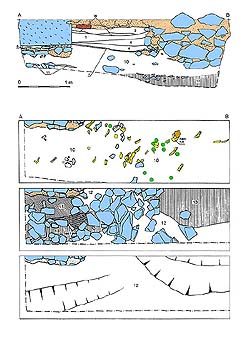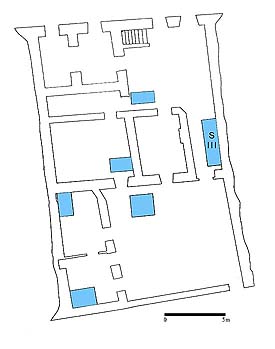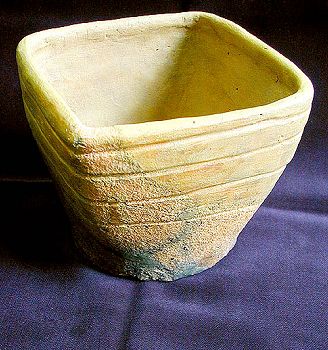The archaeological research of the house No. 23 in the area called Latrán
 In 1994 during the
complete restoration work of the
house No. 23, the archaeologists of The
Český Krumlov District National History and Geography Museum
did archaeological probing on its ground-floor. Altogether six
probing were searched . Almost analogues situation was found in all
of them. The place had been used as the rubbish heap from the
second half of the 13th century to the late 15th century. It could
have been a spare place among out-buildings ( simple wooden
buildings and penthouses), but not a stone house interior. A large
number of pottery collection dating from the 2nd half of the 13th
century was excavated from the lower parts of several tenths
centimetres thick waste layer.
In 1994 during the
complete restoration work of the
house No. 23, the archaeologists of The
Český Krumlov District National History and Geography Museum
did archaeological probing on its ground-floor. Altogether six
probing were searched . Almost analogues situation was found in all
of them. The place had been used as the rubbish heap from the
second half of the 13th century to the late 15th century. It could
have been a spare place among out-buildings ( simple wooden
buildings and penthouses), but not a stone house interior. A large
number of pottery collection dating from the 2nd half of the 13th
century was excavated from the lower parts of several tenths
centimetres thick waste layer.
Besides a glass vessel fragment ( a bottle with an inside
ringlet ), a pottery cup stipe - imported from Podunají , an iron
bolt into the crossbow, a vessel-shape tile with a square
mouthpiece, one of the oldest in the Czech Republic ranks among the
most valuable discoveries.
The objects dating from the 14th century are almost missing. Many objects dating from the 15th century were found in the upper grey-and-black waste layer. A large number of pottery fragments, some waste stuff from the girdler´s workshop ( copper and bronze clasps, fasteners, sewn-on pieces, needles, pins, etc. ), and many animal bones and a big bear tooth.

|

|
|

|

|
In the 15th century a stone house was built on its place. The peripheral walls were preserved. The existence of waste layers that grew until the second half of the 13th century ends in the house interior. Only several inexpressive thoroughfare and construction horizons were picked up between the waste layer and the current surface.
(me)
Further information :
The archaeological researches in the town of Český
Krumlov
The archaeological research of the medieval town of Český
Krumlov

